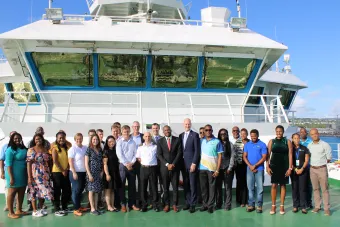
Scientists from the UK’s National Oceanography Centre (NOC), in collaboration with Seafields, Integrated Environmental Solutions (INES) and the University of the West Indies, Cave Hill Campus Barbados (UWI), have started a project in the Caribbean to improve our understanding of the potential effects of using seaweed to store carbon dioxide from the atmosphere. The project is co-funded by the UK Foreign, Commonwealth and Development Office.
The Evaluating the Effects of Seaweed Sinking in the Caribbean (SeaSINC) project aims to conduct the first pilot study of seaweed deposition in the Caribbean to better understand how it affects deep-sea ecosystems and environments. The knowledge gained from this study will be critical for assessing whether burying seaweed can be used as a marine carbon dioxide removal (mCDR) technique in the battle against climate change.
The first phase of the project – a thorough assessment of the experimental sites that will be used in Barbados – has just been completed onboard the UK’s RRS James Cook. Scientists from all organisations participated in the research expedition, which mapped and sampled the seafloor and overlying water column at depths of 1000m and 4000m. The next phase of the project, to be conducted in spring 2024, will deposit a small amount of Sargassum (a type of seaweed found throughout the Caribbean region) on the seafloor with equipment that will continuously monitor and record any changes in the environmental conditions.
Speaking on the groundbreaking study, Dr Christopher Pearce, Principal Marine Geoscientist at NOC and project lead, said: “SeaSINC aims to address critical knowledge gaps in our understanding of the effects of sinking seaweed in the deep ocean and its ecosystems. It will provide the information required to help decide if, where, and how the deposition of seaweed in the deep ocean can be used as a marine carbon dioxide removal approach in support of climate mitigation requirements.”
Seaweed deposition is one of several mCDR approaches believed to have the potential to help fight against climate change. The harmful CO2 particles in the atmosphere dissolve into the oceans and get locked into the seaweed’s organic structure. Burying the seaweed in deep, cold marine environments before it decomposes may then enable that CO2 to be locked away for thousands of years. However, the effects of this sequestered carbon on the deep sea environment is currently unknown, which is what the SeaSINC project aims to address.
Commenting on the study, John Auckland, co-founder and CEO of Seafields, said: “By mapping the oceans, which cover 70 per cent of the Earth's surface, we can amplify and increase the speed at which they can store excess carbon. Scientists agree that the Sargassum seaweed problem is a symptom of climate change and human activity. Sargassum sinks naturally at the end of its life cycle, and it is crucial to better understand what happens when this natural process is enhanced by the controlled deposition of Sargassum at selected sites on the deep-sea floor. This method has great potential to be a viable, safe, and scalable way to remove significant carbon from the atmosphere.”
Sargassum seaweed is found naturally in the Atlantic and Caribbean, with the greatest concentrations found in the Great Atlantic Sargassum Belt (GASB). Large quantities of the seaweed frequently inundate Caribbean coastal regions and wash up on beaches where they can interfere with local ecosystems and fishing areas. They also negatively impact tourist spots, as the washed up sargassum produces an unpleasant sight and smell when it rots on beaches. The results of this project will help assess whether the deposition of sargassum could be an appropriate solution for Caribbean islands with limited land space to deal with these inundations.
Scott Furssedonn-Wood, British High Commissioner to Barbados and the Eastern Caribbean, said, “Sargassum is a major problem for the Caribbean. The UK is delighted to be co-funding this research which will help our Caribbean partners find solutions to the regional inundations of Sargassum of recent years.”
SeaSINC is a non-commercial project developed by the NOC and Seafields, together with the other partners. The study is expected to last for three years, with a visual inspection of the study sites and collection of the deposited sargassum and scientific instruments scheduled to take place in 2025.